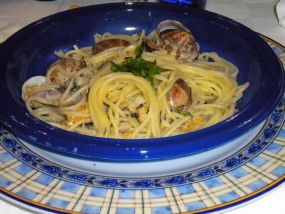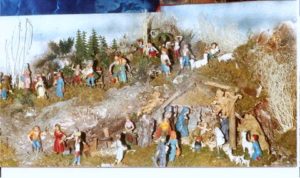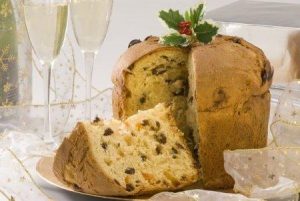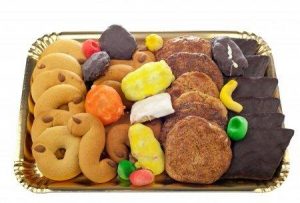
Traditional Christmas Feast
(“Cena della Vigilia e Cenone di Natale”)
When Jesus Christ was born and the new Judeo-Christian religion was introduced, the Christian religion was badly accepted and outlawed. The neophytes Christians in order to celebrate the holy days without being too evident and to avoid incarceration or crucifixion, made the Christian celebrations coincide with the pagan festivities. When Christianity was accepted, many of the pagan feasts endured but were transformed into Christian holidays. They were a mixture of ancient pagan traditions and magic, combined with the rituals of the new Judeo-Christian faith. In Italy, the birth of Jesus originally was celebrated by observing a 24 hours fasting prior to Christmas Eve, and on the Eve, before going to midnight Mass, the fast was broken with a light dinner without meat. At the beginning, the light dinner consisted of locally caught fish and in the hinterland of eels which could be caught in waterways, in pound and streams.
Christmas day was a day of celebration and a special dinner was served according to the local traditions, available food, and the family economic conditions. As time went by, the food prepared for the Christmas Holiday has been subjected to changes and affected by the new lifestyle and different cooking manners which varied from place to place. In fact, although Christmas Day is rejoiced by all with a special dinner, in some regions Christmas Eve is observed with fasting and prayers, in other areas, it is a meatless meager meal and in other areas, it has become a true Lucullan banquet consisting of a variety of fish, pasta and sumptuous desserts.
December 25, Natale, is a holiday celebrated almost all over the world, by Christians and by a very large number of lay people with rich formal dinners, with the exchange of gifts, with gleaming house decorations and great offering of merchandise from stores, markets and malls where this holiday has given to businesses the opportunity to generate extra sales, making the profit of this period a good percentage of the year trading.
Traditional rules are strictly observed by some families, featuring Christmas Eve dinners proposing three fish courses to symbolize the three Wise Men, or seven fish courses to symbolize the biblical seven days of the creation, or thirteen fish courses to symbolize the twelve Apostles and our Lord Jesus.
On Christmass Eve, in our family eatery, “Joe’ of Avenue U the Focacceria Palermitana”, in Brooklyn, NY, costumers who were Italian or of Italian origins, would order three, seven, or more different tye of fish, to carry on the family traditions.
In Italy, the traditions are typically respected in the countryside by a small number of persons whereas the majority of people have substituted the natural and simple local fares, with exotic dishes and complex dinner menus with the exception of the eels and/or baccala’ present on Christmas Eve on every table.
The typical Neapolitan and southern Italian traditional Christmas Eve menu’ include: pasta with clams, mussels or fish sauce; capitone fritto – fried eels, baccala’– salted cod, aragoste al limone o fra’ diavolo – lobsters in lemon sauce or in a spice sauce, calamari fritti o in salsa – fried or stewed squid, scungilli – conches and polpo – octopus.



Other fish that are locally caught are broiled, fried or cooked in sauce; an assortment of vegetable and salads are served sautéed fried or stuffed, moreover in Naples the Insalata di Rinforzo made with boiled cauliflower, pappacelle (pickled peppers), olives, giardiniera, capers, salted anchovies and oil and vinegar, is a ritual dish consumed on the Eve and on Christmas Day.
Also on every table are always present mustaccioli, strufoli, and other desserts, along with dry fruits and assorted nuts.
Christmas Day’s options are unlimited: appetizers, baked pasta, stuffed capon, ham, elaborate recipes with veal or beef, side dishes of vegetables in season, fruits, lavish desserts and again in the region of Naples, another ritual dish is consumed on Christmas Day, the Minestra Maritata (Married Soup). Married Soup is a rich broth made with pork loin, and a mixture of sausages, capicollo, salami, pancetta, prosciutto, and soppressata, cut into bite-size pieces; after the meats are cooked the soup is “married”, which is combined with coarsely chopped cabbage, broccoli rape, chicory, escarole, kale and diced cheese. Then it is simmered until the vegetables are tender and their taste is blended into the broth; it is served warm with grated caciocavallo cheese on the side.
MY CHRISTMAS CELEBRATION IN PALERMO
When I lived in Palermo, in our family, for la Vigilia, Christmas Eve, we ate a thick stew prepared with chunks of boneless fish in a light tomato sauce and garnished with parsley and saffron.
Shrimps, calamari and fish sliced in small pieces or bits of fillets were floured and fried; baccala’ salad with lemon dressing was served besides sarde a beccafico or stuffed fillets of sole as well, my mother’s specialty, a variety of fried vegetables, primosale cheeses and baccala’ “a pastetta” which was a batter of flour and eggs that would absorb very little oil and with a taste that only she could create.
Salads and vegetables were part of the feast and without fail the traditional smoked herrings and olive salad. For a sweet finish of the Eve, my mother would prepare another of her specialties: the virgins’ breast – “Minni di Vergine”-, a fried pastry, leavened with yeast, eggs and milk, flavored with cinnamon and stuffed with ricotta, sugar and chocolate.
Before going to midnight Mass, around 10 PM. hot boiled polpo- octopus – would be served with lemon and salt: a strica sali, meaning with salt and without dressing. The leftover polpo, calamari salad and other fish would be combined into a delicious antipasto on Christmas Day and the leftover batter-fried cardoons, cauliflower, artichokes, primosale – a soft, fresh cheese – were eaten greedily as we viewed the Nativity Set – “il Presepio” (Presepe) – built every year with the help of the whole family.


For Christmas Day, aside from the fish antipasto, a memorable and rich dinner was served featuring anelletti al forno con sugo di carne – baked ring-shaped pasta with ragu’- a specially prepared veal or beef fillet dish with potatoes, green salad, two or three vegetables, cheeses, fresh fruits, buccellato – the Sicilian fig cake – Sicilian cassata and the classic Christmas fruit cake,- il Panettone . Distinctive wines were served with the dinner, including a favorite sweet wine to go with the desserts, Passito di Pantelleria, preferred by my family. In the Island, traditionally Christmas Eve dinner is meatless although it varies from place to place; Christmas is a day of celebration and the meal is made with special dishes even in the poorest families.


In some Sicilian towns lobsters are served boiled with lemon and oil, baked clams are stuffed with aromatized breadcrumbs, sardines are made beccafico, baccala’ is baked with cauliflowers, and in other cities, their own customs are followed meticulously.
For instance in Messina, the mussels from the salt lake of Ganzirri are an exceptional condiment to a pasta dish served for Christmas Eve, in concert with fried baccala’ and the “pituni frittu” a fried turnover filled with sautéed escarole, anchovies, fresh cheese and dry tomato. In America, the exposure to the various ethnic styles of cooking has influenced our preferences and on many Sicilian tables you will find caviar and smoked salmon, champagne instead of spumante, many strange dishes and ready cooked restaurant food, something unthinkable a generation ago.
